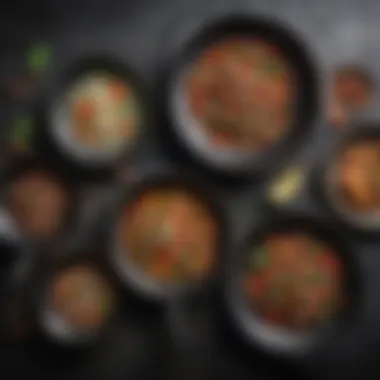The Importance of Non-Toxic Skillets in Cooking


Intro
In the realm of contemporary cooking, the choice of cookware plays a pivotal role in both health and efficiency. Non-toxic skillets have surged in popularity, not only for their practical benefits but also for their alignment with health-conscious and environmentally-friendly practices. This discussion delves into the characteristics, advantages, and broader significance of these skillets, providing culinary enthusiasts with valuable insights.
Key Points Discussed
In order to understand the relevance of non-toxic skillets, several key points will be explored. The material composition of these skillets is of paramount importance, particularly in how it impacts both cooking performance and health outcomes. Moreover, environmental implications of cookware are increasingly significant, reflecting a growing trend towards sustainability in kitchen practices. Lastly, practical usage tips will be provided, catering to a diverse audience keen on enhancing their culinary experiences.
Material Composition
Understanding the types of materials used in non-toxic skillets is essential. Common materials include ceramic, stainless steel, and cast iron, each offering unique benefits. For instance, ceramic skillets are known for their excellent non-stick properties without harmful chemicals. Stainless steel skillets are durable and resistant to warping, while cast iron skillets are renowned for their heat retention and natural non-stick surface when seasoned properly. Evaluating these materials helps in making informed choices that align with personal cooking styles.
Environmental Implications
Choosing non-toxic skillets also contributes to environmental well-being. Many traditional skillets release toxic compounds upon heating, impacting indoor air quality and the broader ecosystem. In contrast, non-toxic alternatives often use sustainable materials that reduce this negative impact. Fostering awareness about these cookware options can promote healthier kitchens and, by extension, a healthier planet.
Health Benefits
Using non-toxic skillets can significantly alter one's cooking experience. Skillets free of harmful chemicals prevent leaching into food, representing a safer option for meal preparation. These benefits extend beyond immediate health; they support long-term well-being, particularly for vulnerable populations such as children or pregnant women.
"By opting for non-toxic cookware, one takes a proactive step towards safeguarding their health and enhancing their culinary journey."
Practical Usage Tips
To maximize the advantages of non-toxic skillets, several practical tips will be outlined.
- Preheat Properly: It is advisable to preheat skillets slowly to prevent warping and ensure even cooking.
- Use Appropriate Utensils: Silicone or wooden utensils can extend the lifespan of non-toxic skillets, reducing scratches.
- Cleaning Techniques: Gentle cleaning methods are recommended. Avoid abrasive sponges that can damage the non-stick coating.
These practical insights aim to enhance the user's experience, ensuring they can fully benefit from their investment in non-toxic cookware.
Intro to Non-Toxic Cookware
The use of cookware in our kitchens is often taken for granted, yet it plays a pivotal role in our health and cooking experiences. Non-toxic cookware stands out as an essential element in modern cooking. This article delves into the significance of non-toxic skillets, exploring their numerous benefits and their impact on our daily culinary practices. By choosing non-toxic options, individuals not only look after their health but also make environmentally conscious decisions.
Defining Non-Toxic Cookware
Non-toxic cookware refers to kitchen tools made from materials that do not release harmful chemicals into food when heated. This definition encapsulates skillets that avoid coatings or substances typically found in conventional cookware, such as polytetrafluoroethylene (PTFE) or perfluorooctanoic acid (PFOA). Instead, non-toxic skillets utilize safer materials like cast iron, stainless steel, or ceramic coatings. Each of these materials provides unique qualities that cater to different cooking methods without posing health risks associated with toxic cookware.
Importance of Cookware Safety
Cookware safety is an often overlooked aspect of food preparation. The materials used in making skillets can significantly affect health outcomes. When food is cooked with conventional non-stick skillets, it can lead to the leaching of chemicals that may be harmful. Such chemicals have been linked to various health issues, including hormonal disruptions and increased risk of certain diseases.
Making informed choices about the cookware we use is crucial. The use of non-toxic skillets can greatly reduce the potential for chemical exposure. This shift in cooking habits contributes to a healthier lifestyle and promotes better food quality. As consumers become more knowledgeable about cookware safety, they empower themselves and others to prioritize health in cooking.
Materials Commonly Used in Non-Toxic Skillets
The choice of materials in non-toxic skillets is significant, as it directly impacts health, flavor, and cooking performance. By being mindful of the materials selected, cooks can enhance their culinary experiences while minimizing potential harm from toxic substances. Not only do these materials provide necessary durability and efficiency in cooking, but they also offer various health benefits. Understanding the characteristics of each material will help consumers make informed decisions when choosing skillets for their kitchen.
Cast Iron
Cast iron has long been a favorite for many chefs due to its exceptional heat retention and even cooking. Non-toxic skillets made from cast iron are inherently safe as they do not leach harmful chemicals into food. Moreover, adding a small amount of iron to cooking can be beneficial to health, especially for those who may have iron deficiencies. However, it is essential to maintain cast iron skillets properly; regular seasoning with oils helps maintain their non-stick surface and prevents rust. The downside can be their heavy weight and the need for a bit of extra care during cleaning.
Stainless Steel


Stainless steel skillets are known for their durability and versatility. They provide a non-reactive surface, meaning they do not interact with foods or alter their flavor. Non-toxic stainless steel skillets are often preferred by cooks who want a reliable and long-lasting option. With a proper quality finish, these skillets resist scratching and staining, allowing them to maintain their appearance over time. A potential concern is the heat conductivity, which may not be as even as some other materials. However, many stainless steel options now feature aluminum or copper cores to enhance heat distribution.
Ceramic Coatings
Ceramic-coated skillets are an innovative choice for those seeking non-toxic cookware with non-stick properties. The coating is created from natural materials and often free from harmful chemicals such as PTFE and PFOA. These skillets are gentle on food, making them ideal for low-fat and health-conscious cooking. Additionally, ceramic coatings allow for easy cleanup. Users should take care, though, as the coatings can be prone to scratches if metal utensils are used. It is advisable to use wooden or silicone tools when cooking with ceramic-coated skillets.
Hard-Anodized Aluminum
Hard-anodized aluminum skillets are lightweight yet incredibly durable. The anodization process strengthens the aluminum, making it resistant to scratches and corrosion. This type of skillet is also generally safe and does not leach aluminum into food. Furthermore, they offer excellent heat conductivity, contributing to more consistent cooking results. However, it is important to avoid heating hard-anodized aluminum skillets excessively, as high temperatures can damage the non-toxic finish and reduce their lifespan.
Assessing Health Risks Associated with Conventional Cookware
Understanding the health risks related to conventional cookware is crucial in the context of modern cooking. Many consumers are not fully aware of the potential hazards that arise from using certain types of cookware. This section delves into the implications of chemical leaching and long-term health effects associated with common materials used in conventional cookware. By identifying these risks, readers can make more informed decisions regarding their culinary tools and ultimately enhance their overall well-being.
Chemical Leaching
Chemical leaching refers to the process where substances from cookware materials dissolve into food during cooking. In conventional cookware made from materials like Teflon, aluminum, or non-anodized stainless steel, this can pose significant health risks. For instance, Teflon coatings can release toxic fumes when heated to high temperatures, leading to the dispersion of harmful chemicals into the air and food.
Moreover, aluminum cookware has been linked to potential health issues such as Alzheimer’s disease. Although the direct correlation is still a subject of ongoing research, the evidence raises concerns about the safety of using aluminum for cooking.
To mitigate these risks, one should consider using non-toxic options. Materials like cast iron, stainless steel, and ceramic coatings do not leach harmful chemicals into food. Making the switch to these types of cookware is a practical step in avoiding the adverse effects of chemical leaching.
Long-Term Health Effects
The long-term health effects of using conventional cookware are an essential consideration for those invested in culinary practices. Continuous exposure to leached chemicals can result in various health issues over time, including hormonal imbalances, respiratory problems, and digestive complications. The presence of heavy metals and other toxins can accumulate in the body, increasing the risk of chronic diseases.
As consumers become more health-conscious, the demand for safer cookware increases. There is a shift towards materials known for their durability and non-toxicity. Choosing non-toxic skillets may prevent the risk of long-term health problems, supporting not just individual health but also public health.
"Cookware that leaches substances into food not only compromises meal quality but poses serious health risks that can have lasting effects."
Making informed choices regarding cookware is fundamental for ensuring health benefits while cooking. Recognizing and addressing the health risks linked to conventional options can lead to positive changes in dietary habits and food preparation practices.
Benefits of Using Non-Toxic Skillets
Using non-toxic skillets holds significant importance for both culinary practices and health in modern cooking. This section explores the specific benefits that such skillets provide, addressing health aspects, environmental impacts, and cooking performance. Awareness of these factors can enhance decision-making for those who wish to cook healthier meals.
Enhanced Health and Wellness
One of the most compelling reasons to utilize non-toxic skillets revolves around health advantages. Traditional cookware, particularly those made with materials that may leach harmful chemicals or heavy metals, can pose health risks. Non-toxic skillets, in contrast, are crafted to avoid such issues. For instance, skillets made from cast iron, stainless steel, or ceramic coatings do not release toxic substances under high heat, contributing to a safer culinary environment.
Health benefits also extend to food quality. Cooking with non-toxic skillets ensures that meals maintain their nutritional integrity. Chemical leaching from conventional pans can alter flavors and diminish the food's overall nutritional value. Therefore, by choosing non-toxic options, consumers can experience meals that are not only safer to eat but also taste better. This awareness can lead to improved health and wellness across the board.
Environmental Advantages
The environmental impact of cookware choices is becoming increasingly crucial in our global landscape. Non-toxic skillets often use sustainable materials and manufacturing practices. For instance, brands that create skillets from recycled materials or those that focus on energy-efficient production processes contribute positively to the environment.
Furthermore, non-toxic skillets tend to have longer lifespans compared to their conventional counterparts. This durability leads to less frequent replacements, thus reducing overall waste. The environmentally conscious consumer will appreciate how selecting these skillets supports both personal health and the planet's well-being. The push for eco-friendly choices continues to influence cooking trends and consumer preferences.
Improved Cooking Performance
Beyond health and environmental aspects, non-toxic skillets are noted for their excellent cooking performance. Many non-toxic skillets distribute heat evenly, which is essential for achieving superior cooking results. For example, cast iron skillets retain heat well, allowing for the perfect sear on meats and excellent heat management for cooking diverse dishes.
Another benefit lies in non-stick properties. Many non-toxic options present non-stick surfaces without the harmful chemicals found in typical non-stick cookware. This feature simplifies cooking and makes cleaning effortless. Home cooks can use less oil or fat, leading to healthier meals without compromising flavor or texture. Ultimately, switching to non-toxic skillets can elevate both the cooking experience and the quality of dishes prepared.


"Investing in non-toxic skillets not only safeguards health but also enhances the culinary experience, promoting sustainable practices in the kitchen."
The cumulative benefits of using non-toxic skillets cannot be overstated. They present an intersection of health, environmental responsibility, and superior cooking performance, making them a valuable addition to any kitchen.
How to Choose the Right Non-Toxic Skillet
Selecting the right non-toxic skillet is essential for any cooking enthusiast. With increasing awareness about health and environmental issues, the choice of cookware has become more significant. Non-toxic skillets not only support healthier cooking but also offer varied benefits in performance and sustainability. Knowing how to navigate the options available in the market can help consumers make informed choices.
Analyzing Product Labels
When buying a non-toxic skillet, the label plays a crucial role in your decision-making process. Most manufacturers provide detailed information about the materials and coatings used in their products. Here are a few things to look for:
- Material Composition: Ensure that the skillet is made from safe materials such as cast iron, stainless steel, or ceramic coatings. Avoid options with harmful elements like PFOA or heavy metals.
- Certification Standards: Check for labels that indicate compliance with safety standards. Look for certifications from organizations such as the FDA or brands that proudly show their products are free from toxic chemicals.
- Care Instructions: Labels often include care instructions that help maintain the longevity of the skillet. Proper maintenance can ensure that the non-toxic properties remain effective over time.
Understanding these elements can clarify which skillets genuinely prioritize safety and health benefits.
Consumer Reviews and Ratings
Consumer reviews and ratings provide additional insights into the functionality and satisfaction level of a skillet. Here is why they are useful:
- Real-World Experience: Feedback from others who have used the product sheds light on its performance handling daily cooking tasks. A skilled construction ensures durability and usability.
- Comparative Performace: Reviews often compare different brands, revealing which ones stand out in terms of safety, ease of use, and heat distribution.
- Avoiding Poor Choices: Reading experiences can help avoid products that may look appealing but do not deliver on safety. Negative reviews highlight issues such as peeling coatings or uneven heating, which can significantly impact cooking.
When examining consumer feedback, pay attention to common themes and recurring issues that may affect your cooking experience.
"Choosing the right non-toxic skillet involves understanding both the material and real user experiences, ensuring you invest wisely in cookware that prioritizes your health."
Caring for Non-Toxic Skillets
Caring for non-toxic skillets is a crucial aspect of ensuring their longevity and effectiveness in the kitchen. With the proper care, these skillets can offer both health benefits and practical advantages for a long time. Understanding how to maintain them can enhance materials' performance while ensuring they remain safe for cooking. This section will discuss essential cleaning methods and strategies to avoid damage.
Cleaning and Maintenance Tips
Proper cleaning and maintenance are vital for the upkeep of non-toxic skillets. Here are some tips to keep in mind:
- Use Gentle Cleaners: Avoid harsh chemicals. Instead, opt for natural cleaners, such as a mixture of vinegar and baking soda. These are effective yet safe.
- Hand Wash Instead of Dishwasher: Many non-toxic skillets do not fare well in dishwashers due to high heat and strong detergents. Hand washing with warm soapy water is often best.
- Dry Immediately: After washing, promptly dry your skillet with a soft towel to prevent water spots and rusting.
- Season if Needed: Some materials like cast iron require seasoning. An occasional application of oil can help maintain their non-stick properties.
By following these simple practices, you can ensure that your non-toxic skillets remain in excellent condition.
Avoiding Damage and Ensuring Longevity
To extend the lifespan of your non-toxic skillets, it is important to avoid practices that can lead to damage. Here are several considerations:
- Avoid Metal Utensils: Using wooden or silicone utensils can prevent scratches on the surface of your skillets, especially with non-stick coatings.
- Control Heat Levels: Overheating can damage various materials. Always use medium or low heat, which helps maintain the skillet’s coating.
- Store Properly: Stack skillets carefully, placing cloth between them to prevent scratches. Keeping them in a dry environment is also key to preventing rust.
- Check for Damages Regularly: Inspect your skillets periodically for any signs of wear and tear. Addressing small issues early can prevent more significant problems later.
By investing time in care and maintenance, you significantly extend the lifespan of your non-toxic skillets, ensuring they serve you well for many years.
Integration into Daily Cooking
Incorporating non-toxic skillets into everyday cooking is not just a trend but a significant shift towards healthier culinary practices. Skillets are versatile tools in the kitchen, and using them with non-toxic materials offers numerous advantages. As consumers become more aware of the long-term impacts of toxic substances, the demand for safer cookware increases. Non-toxic skillets enhance not only food safety but also overall cooking experiences.
One of the key considerations when integrating non-toxic skillets into daily cooking is understanding their various uses. These skillets can handle a multitude of cooking techniques, from sautéing vegetables to frying meats. Transitioning to non-toxic cookware is more than just about health; it influences cooking performance as well. Many non-toxic skillets distribute heat evenly, leading to better results in meal preparation. This helps to avoid uneven cooking, which can affect the quality of dishes.
Moreover, using non-toxic skillets supports environmentally friendly practices. Many brands focus on sustainable materials and manufacturing processes. By choosing such products, consumers contribute to a broader movement aimed at reducing ecological footprints.


"Cooking with non-toxic skillets is not just about food—it is part of a lifestyle that prioritizes health and safety."
Another factor is the ease of maintenance. Non-toxic skillets can often withstand high temperatures, reducing the need for excessive oil or non-stick sprays. This can lead to a healthier way of cooking, as it encourages the natural flavors of food to shine without the interference of chemical residues.
In terms of practicality, non-toxic skillets are generally easy to clean and maintain. Their durable surfaces resist sticking and scratching, which means cleanup can be quick and simple. This characteristic is particularly appealing to busy individuals who may not have time for extensive kitchen maintenance.
In summary, the integration of non-toxic skillets into daily cooking offers a variety of benefits: enhanced health, improved cooking performance, and a positive environmental impact. Recognizing these advantages can empower consumers to make informed choices that resonate well with their cooking habits and lifestyle.
Best Practices for Use
When utilizing non-toxic skillets, it is essential to adopt best practices that enhance their performance and longevity. A few core principles can elevate the user experience:
- Preheat Properly: Heat the skillet gradually before adding ingredients. This helps in achieving that perfect sear and reduces the chance of food sticking.
- Use Suitable Utensils: Opt for silicone, wood, or plastic utensils. Metal tools can damage non-toxic finishes, leading to premature wear.
- Control the Heat: Non-toxic skillets often require lower heat settings for optimal performance. This not only protects the surface but also promotes better flavor development.
By following these practices, cooks can maximize the benefits of their non-toxic skillets while enjoying flavorful and healthy meals.
Recipe Adaptations for Non-Toxic Cookware
Adapting recipes for use with non-toxic skillets is another essential consideration. Many existing recipes may require slight adjustments to accommodate the unique properties of these skillets. Here are key adjustments:
- Alter Cooking Times: Due to better heat retention in non-toxic skillets, you might need to reduce cooking times slightly to prevent overcooking.
- Experiment with Temperatures: Some recipes made for conventional pans may need modification in temperature settings. Start at a lower heat and adjust as needed.
- Ingredient Arrangements: Group ingredients strategically. Slightly different cooking times can impact how effectively food is cooked. For example, harder vegetables may need more time than more delicate ones, so consider staggering their additions to the skillet.
In summary, successful integration of non-toxic skillets into daily cooking requires understanding their advantages and adapting cooking techniques and recipes accordingly. The effort invested can lead to healthier meals and a more enjoyable cooking process.
Debunking Myths Surrounding Non-Toxic Cookware
In the realm of cookware, non-toxic options often face skepticism. Debunking myths surrounding this type of cookware is crucial. Misunderstandings can lead to poor choices that compromise health and cooking performance. By clarifying these myths, we can empower consumers to make informed decisions.
Cost vs. Performance
One common myth is that non-toxic skillets are overpriced compared to their traditional counterparts. While it is true that some brands – like Greenpan or Scanpan – may carry a higher price tag, this often reflects quality and safety standards. These skillets are designed to last longer and provide better cooking results without the risk of harmful chemical exposure.
Investing in non-toxic options can save money in the long run. They tend to endure more wear and tear, reducing the need for frequent replacements. Furthermore, they often offer superior non-stick properties without synthetic coatings, leading to less oil usage and healthier cooking. When considering cost versus performance, it is important to look beyond the initial investment.
Durability Misconceptions
Another myth is that non-toxic skillets lack durability. For example, ceramic-coated skillets, while perceived as delicate, often withstand a high degree of thermal shock and scratching when properly cared for. Similarly, cast iron skillets are renowned for their incredible durability and can last a lifetime if maintained correctly.
To address durability effectively, consumers should focus on how these skillets are used and cared for. Many assume that non-toxic means fragile, but many skillets in this category can handle high heat and heavy use.
Ultimately, knowledge about the different materials and care methods can dispel doubts regarding their lifespan.
Key takeaway: Understanding the true cost and durability of non-toxic skillets can change the perspective on investing in healthier, safer cooking tools.
The End: The Future of Cookware Choices
The conversation surrounding cookware safety is becoming increasingly important. Non-toxic skillets represent not only a healthier option but also signify a shift in consumer awareness and preferences. People are more conscious of what they eat and how it is prepared. Choosing non-toxic cookware directly affects the quality of food, which in turn influences overall health. As more information becomes available about the dangers posed by conventional cookware, the demand for safer alternatives like non-toxic skillets is expected to rise.
The Role of Consumer Awareness
Consumer awareness serves as the backbone of the non-toxic cookware movement. Knowledge is power, and being informed about the materials used in everyday cooking tools can lead to better choices. As consumers understand the potential health risks associated with harmful substances found in traditional cookware, they begin to seek safer, non-toxic alternatives. For example, individuals are more likely to choose skillets made from materials like cast iron or stainless steel, as these materials have proven to be safe and effective. A growing awareness of the ingredients in our food also extends to the cookware used to prepare it.
The availability of detailed product information, reviews, and consumer forums, like those found on Reddit or Facebook, provides essential insights into making informed decisions. Websites like Wikipedia and Britannica can also serve as educational resources.
"Awareness leads to better choices, creating a demand for products that prioritize health and safety."
Advancements in Non-Toxic Cookware Technology
Technology continues to play a crucial role in the evolution of non-toxic cookware. Manufacturers are developing innovative materials and coatings that enhance performance while maintaining safety standards. For example, ceramic coatings that are free of harmful chemicals have become increasingly popular. These advancements are also aimed at improving the longevity and durability of cookware.
Research and development in cookware technology not only make it possible to create non-toxic options but also ensure that these products perform well in the kitchen. Enhanced heat distribution, scratch resistance, and ease of cleaning are just a few benefits that modern non-toxic skillets can offer. As advancements continue, it is likely that non-toxic cookware will become the norm rather than the exception.















